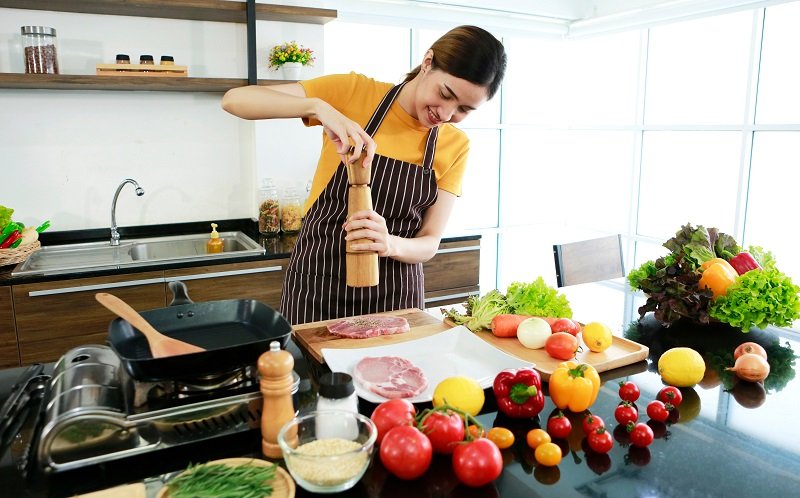In today’s fast-paced world, families often struggle to find quality time together. Amid busy schedules, the simple act of cooking can become a powerful tool for connection, education, and health. Preparing meals together as a family not only fosters stronger relationships but also encourages healthier eating habits, promotes life skills, and supports emotional well-being. Cooking together offers an opportunity to combine creativity, nutrition, and shared experiences, creating lasting memories that extend beyond the dinner table. This article explores the numerous benefits of family cooking and provides practical strategies for making it enjoyable, engaging, and plant-based.
Nutritional and Health Benefits

1. Encourages Healthier Eating Habits
Families who cook together are more likely to prioritize nutrient-rich, whole foods over processed options. Preparing meals from scratch allows parents to control ingredients, reducing added sugars, salt, and unhealthy fats. Involving children in meal preparation exposes them to fruits, vegetables, whole grains, legumes, nuts, and seeds, increasing their acceptance of plant-based foods. Studies have shown that children who participate in cooking are more likely to try new foods, eat a wider variety of vegetables, and develop healthier eating habits that last into adulthood.
2. Supports Balanced Nutrition
Cooking at home provides the flexibility to create balanced meals that meet the nutritional needs of all family members. Whole foods and plant-based ingredients are rich in vitamins, minerals, antioxidants, and fiber. Incorporating colorful vegetables, fruits, legumes, and grains ensures that meals are nutrient-dense, supporting growth, immune function, and long-term health. Families can experiment with different grains like quinoa, millet, or brown rice, and protein sources such as lentils, chickpeas, tofu, or tempeh, creating diverse, satisfying meals.
3. Promotes Portion Control and Mindful Eating

Cooking at home encourages mindfulness around food. Families learn to serve appropriate portion sizes and pay attention to hunger and fullness cues. By engaging in the process of selecting, preparing, and plating meals, children develop awareness of their eating habits. Mindful cooking and eating help prevent overeating and contribute to a healthy relationship with food.
Emotional and Social Benefits

1. Strengthens Family Bonds
Cooking together fosters communication, collaboration, and teamwork. Assigning age-appropriate tasks, from washing vegetables to stirring sauces, encourages participation and shared responsibility. Engaging in this shared activity strengthens emotional connections and creates a sense of unity. Mealtime conversations, laughter, and collaborative problem-solving enhance family cohesion and reduce stress.
2. Builds Confidence and Self-Esteem
Involving children in meal preparation instills a sense of accomplishment and pride. Completing a recipe or successfully creating a dish boosts confidence and self-esteem. When children see that their contributions are valued, they feel empowered and motivated to engage further, both in cooking and in other areas of life.
3. Encourages Creativity and Experimentation
Cooking together stimulates creativity, allowing family members to experiment with flavors, colors, and textures. Children can explore new fruits, vegetables, grains, and spices, learning to combine ingredients in imaginative ways. This experimentation promotes curiosity, innovation, and problem-solving skills while making mealtime fun and engaging.
4. Reduces Screen Time
Shared cooking experiences provide a natural alternative to digital distractions. Engaging in meal preparation encourages interaction, conversation, and hands-on learning, reducing the time children and adults spend on screens. By making cooking a regular family activity, families cultivate a more connected and balanced lifestyle.
Educational Benefits

1. Teaches Life Skills
Cooking together equips children with essential life skills, such as meal planning, grocery shopping, and food preparation. These skills foster independence and self-sufficiency, preparing children for adulthood. Learning to read recipes, measure ingredients, and follow instructions also enhances literacy, numeracy, and critical thinking skills.
2. Encourages Nutritional Literacy
Involving children in cooking provides opportunities to teach them about nutrition, food origins, and healthy eating principles. Families can discuss the benefits of different fruits, vegetables, grains, and legumes, helping children make informed choices about their diet. Understanding the link between food and health encourages lifelong healthy habits.
3. Introduces Cultural Awareness
Cooking together allows families to explore diverse cuisines and culinary traditions. Introducing global flavors, spices, and plant-based ingredients exposes children to different cultures, broadening their understanding and appreciation of food diversity. This fosters openness, curiosity, and a sense of global connection.
Practical Tips for Successful Family Cooking

1. Plan Together
Involve the entire family in meal planning. Discuss what dishes to prepare, select ingredients, and create a shopping list. Planning together encourages ownership and ensures that everyone’s preferences are considered, increasing enthusiasm for participation.
2. Assign Age-Appropriate Tasks
Assign tasks based on skill and age:
- Toddlers: Washing vegetables, stirring, or tearing leafy greens.
- Elementary-aged children: Measuring ingredients, chopping soft vegetables with supervision, mixing batters.
- Teens: Handling more complex cooking tasks, such as sautéing, seasoning, or managing the oven under guidance.
Age-appropriate participation ensures safety and fosters a sense of contribution.
3. Focus on Fun and Exploration
Make cooking enjoyable by experimenting with colors, textures, and flavors. Encourage creativity with plant-based ingredients such as spiralized vegetables, colorful salads, or homemade sauces. Incorporate educational games, like tasting new vegetables blindfolded or creating “rainbow plates” with colorful produce.
4. Keep It Simple
Choose recipes that are straightforward, quick, and suitable for multiple skill levels. Simple plant-based meals such as vegetable stir-fries, grain bowls, salads, soups, and smoothies provide a foundation for fun, nutritious family cooking without overwhelming participants.
5. Practice Patience and Encourage Participation
Allow time for mistakes and learning. Encourage children to try new techniques and taste their creations. Positive reinforcement, praise, and patience foster confidence and a willingness to engage in future cooking activities.
6. Emphasize Hygiene and Safety
Teach proper food handling, washing hands, and using kitchen tools safely. Establishing good hygiene and safety practices early helps children develop lifelong habits that promote health and reduce the risk of foodborne illness.
Creative Family-Friendly Plant-Based Recipes
1. Rainbow Veggie Stir-Fry
- Ingredients: Broccoli, bell peppers, carrots, snap peas, garlic, ginger, soy sauce, sesame oil.
- Preparation: Chop vegetables, sauté garlic and ginger, add vegetables, and toss with soy sauce and sesame oil. Serve over brown rice or quinoa.
- Family involvement: Children can chop soft vegetables and stir the mixture.
2. DIY Grain Bowls
- Ingredients: Quinoa, brown rice, chickpeas, roasted vegetables, leafy greens, avocado, hummus, seeds.
- Preparation: Cook grains, roast vegetables, assemble bowls with toppings.
- Family involvement: Each member builds their personalized bowl, selecting ingredients and arranging toppings creatively.
3. Fruit and Nut Energy Balls
- Ingredients: Dates, almonds, cashews, cocoa powder, shredded coconut.
- Preparation: Blend ingredients, roll into balls, refrigerate.
- Family involvement: Children can measure, blend, and roll the mixture, creating a healthy, sweet treat.
4. Colorful Veggie Wraps
- Ingredients: Whole-grain tortillas, hummus, shredded carrots, cucumber, bell peppers, spinach, sprouts.
- Preparation: Spread hummus, layer vegetables, and roll tightly.
- Family involvement: Children can assemble wraps and experiment with ingredient combinations.
Long-Term Benefits of Cooking Together
- Healthy eating habits: Families develop a preference for fresh, whole foods and balanced meals.
- Stronger bonds: Shared activities create lasting memories and positive family traditions.
- Life skills: Children gain confidence, independence, and culinary knowledge.
- Mental and emotional well-being: Cooking together reduces stress, encourages mindfulness, and fosters a sense of accomplishment and togetherness.
Conclusion
Cooking together as a family is more than preparing meals; it is a powerful tool for connection, education, and health. It encourages healthier eating habits, teaches essential life skills, strengthens family bonds, and fosters creativity, mindfulness, and cultural awareness. By planning meals together, assigning age-appropriate tasks, and making cooking fun and interactive, families can cultivate a love for wholesome, plant-based foods while enjoying quality time.
Incorporating family cooking into daily life supports physical, emotional, and social well-being, creating a positive environment where nutrition, learning, and connection intersect. By embracing the shared joy of preparing meals, families nurture not only their bodies but also their relationships, laying the foundation for healthy habits and memorable experiences that will last a lifetime.
